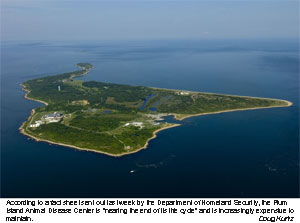PLUM ISLAND: Clinton and Bishop Say, 'Keep It Open', Ask to meet with Homeland Security boss on possible closing of animal disease center

Surprised by the United States Department of Homeland Security's announcement last week that it may replace the Plum Island Animal Disease Center with a new facility able to research more powerful pathogens, Senator Hillary Rodham Clinton and U.S. Representative Tim Bishop have asked Homeland Security Secretary Michael Chertoff to meet with them about the future of the island as soon as Congress returns to Washington this month.
A "Plum Island fact sheet" released by the department by e-mail on Aug. 22 said the 50-year-old research center, classified as a Biosafety Level 3 facility, is "nearing the end of its life cycle" and is becoming increasingly expensive to maintain.
"The laboratory and test space in the current facility is insufficient to support the increasing levels of research and development needed to meet the growing concerns about accidental or intentional introduction of foreign animal diseases into this country," the fact sheet said. "The need to replace this aging facility to meet the new challenges of the coming decades has become increasingly clear."
The president's 2006 budget includes $23 million for a Department of Homeland Security effort to assess the nation's needs, "identify a next-generation biological and agricultural defense facility," and design that facility.
"There are three options," Mr. Bishop said on Friday, "abandon the facility, upgrade it in its existing form, or upgrade the physical plant and introduce Biosafety Level 4."
In an Aug. 24 letter to Mr. Chertoff, Senator Clinton and Representative Bishop said they were distressed not only by the possibility that the Animal Disease Center could be moved off the island, but also by the fact that those plans first came to their attention in the form of a fact sheet. Mr. Chertoff's predecessor, Tom Ridge, promised the two lawmakers "full communication about the issues and developments that affect Plum Island and our common interests," they said in their letter.
"We were not part of any discussions that led to the preparation of that document. I would hope that's an anomaly," Mr. Bishop said. "They have no legal obligation to involve us . . . but we all have the same goal in mind." According to Mr. Bishop, Mr. Ridge also "assured us that the department had a long-range commitment to Plum Island and no intention of upgrading it to a Biosafety Level 4," Mr. Bishop said.
Mr. Bishop is opposed to an upgrade to Biosafety Level 4, but if that is the Homeland Security Department's eventual choice, "we absolutely need enhanced security." He believes the best of the three options would be for the existing facility to be improved within Biosafety Level 3 parameters.
In their letter, Ms. Clinton and Mr. Bishop stressed the importance of the work being done at the Animal Disease Center.
"We want to be sure that you are directly aware of how vital and critical the research conducted by the Plum Island Animal Disease Center is to keeping this nation's food supply healthy," they said. While they agree with the department that infrastructure improvements must be made or a new facility built, they question the idea of relocating the facility elsewhere.
"Plum Island was first established as a foreign animal disease center because of its isolation, with no other communities or buildings occupying the island," they wrote. "In addition the very limited livestock population on the surrounding mainland would limit the extent or possibility of an accidental outbreak of a very contagious and economically devastating disease like foot-and- mouth disease."
The Plum Island facility also provides 200 jobs. "The North Fork would not be well served by closing the facility," Mr. Bishop said. "That's a lot of jobs in the year-round community of eastern Long Island."
When maintenance workers employed by L.B.& B. Associates, the Maryland-based company that operates the physical plant, went on strike in 2002, "the North Fork saw the impact of those lost jobs," Mr. Bishop said. "I think the public perception of the lab moved considerably in the wake of the strike."
During the strike and subsequent lockout, however, a number of incidents raised alarm about safety and security measures on the island. When replacement workers could not operate backup generators during a three-hour blackout in December 2002 and used duct tape to seal the facility's biocontainment labs, Senator Clinton called for temporary closure of the disease center.
At the time, Plum Island was operated by the Department of Agriculture. It has since been placed under control of the Department of Homeland Security. There have been several upgrades to the physical plant and security has been increased. Now, Mr. Bishop said, "Plum Island is a facility that operates at a reasonable level of safety."
"People are concerned and people will always be concerned, but I think there is a broad recognition that this facility is important," he said.
County Executive Steve Levy has joined Mr. Bishop and Ms. Clinton in asking Department of Homeland Security to bring local, state, and federal representatives into discussions about the future of Plum Island.
